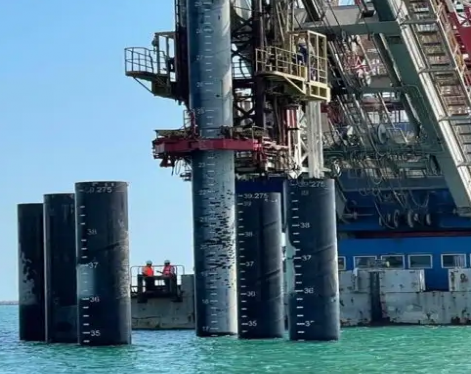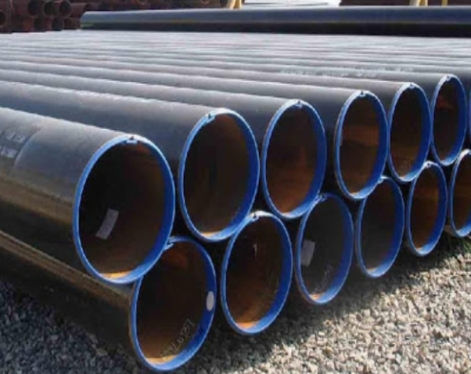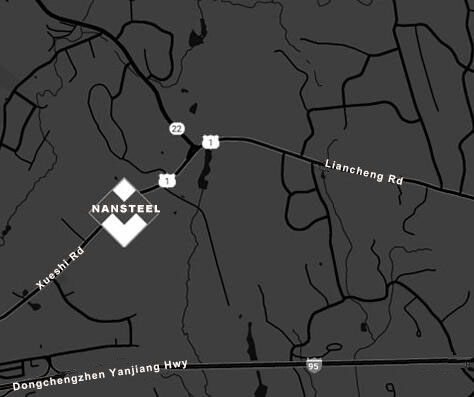In the construction sequence of steel pipe piles, we should first grasp all aspects of the project for comprehensive consideration and analysis, such as construction machinery, construction period, design requirements, geomorphic environment, engineering volume, layout, steel pipe pile specifications and characteristics, geological conditions and other aspects. Below, I will introduce the construction process of steel pipe piles.
1. Steel pipe piles need to be properly stacked.
The stacking site is required to be flat to ensure that large vehicles can enter directly. For low-lying areas of the site, ballast or road timber needs to be laid under the support point for artificial reinforcement, and drainage ditches need to be dug around the site. When stacking steel pipe piles, they need to be stacked according to the specifications of the steel pipe piles to facilitate supporting transportation. When stacking the support point, it must be ensured that the steel pipe piles are not deformed. In addition, the steel pipe piles stacked on site should be placed within the lifting range of the pile driver. Since the steel pipe piles are lifted during lifting, the tops of all steel pipe piles need to face the pile foundation and be arranged in the order of piling.

2. For the steel pipe piles, move the pile driver to the pile position. If a few positions need to be adjusted, the pile driver can be used to adjust them.
Before lifting the steel pipe piles, the appearance of the steel pipe piles should be fully inspected, and special attention should be paid to the ovality of the steel pipe piles and the squareness of the end faces of the H-type steel pipe piles. After the inspection, detailed records need to be made, and the steel pipe piles can be lifted only after they are qualified. When lifting the steel pipe piles, the top of the steel pipe piles needs to be put into the pile cap, and the pile bottom is aligned with the lime line and then inserted. The outer periphery of the H-type steel pipe pile is rectangular, and there are orientation requirements for the arrangement of the piles. It is necessary to ensure that both the longitudinal and transverse insertions are correct; for the right angles presented in front of and on the side of the pile driver, the verticality of the guide rod can be monitored by two theodolites to form a vertical line between the pile body, the pile cap, and the pile hammer.
3. Factors affecting the accuracy of steel pipe pile driving.
Affected by the weight of the steel pipe piles, the piles can slowly sink into the soil by their own weight. This self-sinking situation should be controlled so that it is in a slow progress state, and the hammering work should be carried out after ensuring stability. In the initial stage, the use of hammering operations can easily lead to the state of the diesel hammer being difficult to burn and empty hitting. Therefore, during this period, it is necessary to track and observe the quality of pile sinking at any time. If abnormal conditions are found, measures should be taken in time to correct them. In serious cases, the steel pipe piles should be pulled out and reinserted, and the steel pipe piles should be sunk along the predetermined trajectory through compulsory measures.
4. Steel pipe pile sinking
The steel pipe pile sinking uses a 45KW vibrating hammer, which can provide a rated vibration force of 45t, which can meet the requirements of this project. The lifting equipment uses a 30t crane. After the crane is anchored and positioned, the steel pipe pile is first inserted into the covering layer by gravity, and the upper part is tied to the side of the crane with a cable. After the pile body has a certain stability, the floating crane is used to lift the vibrating pile sinker to clamp the steel pipe pile, and the vibrating pile sinker starts to vibrate and sink the steel pipe pile into place. The steel pipe piles are sunk row by row, and the boat is moved to the other side after a row of piles is sunk.
When sinking steel pipe piles, please note that the center of the vibrating hammer and the center axis of the pile should be kept in the same straight line as much as possible; the sinking of each pile should be continuous, and it should not be paused for too long in the middle, so as to avoid the friction resistance of the soil being restored and the difficulty of continuing to sink. Strengthen observation during the sinking process, the deviation of the steel pipe pile shall not be greater than 10 cm, and the verticality shall not be less than 0.1%.
5. Steel platform erection
After the steel pipe piles are sunk, the drilling platform steel is laid out. The specific steps are as follows:
Each steel pipe pile opens at an appropriate position along the water flow, cuts the steel pipe pile head flat, installs the spliced I45 I-beam crossbeam, and spot welds it with the steel pipe pile (opening) wall → pours C15 concrete on the pile head of each steel pipe pile to embed the I45 crossbeam in the pile head → installs the I36 I-beam distribution longitudinal beam and welds it with the I45 crossbeam (with a stiffening plate) → lays a δ=10mm thick steel plate on the "well" beam and adds a safety railing.
6. At the beginning of the platform construction, safety signs are set up, red lights are hung at night to warn and other guide signs, and steel pipe pile anti-collision piers are set up to ensure safety.
The above is the pile sinking construction process of steel pipe piles introduced to you. I hope you will pay attention to these points during the construction process to ensure good project quality.
1. Steel pipe piles need to be properly stacked.
The stacking site is required to be flat to ensure that large vehicles can enter directly. For low-lying areas of the site, ballast or road timber needs to be laid under the support point for artificial reinforcement, and drainage ditches need to be dug around the site. When stacking steel pipe piles, they need to be stacked according to the specifications of the steel pipe piles to facilitate supporting transportation. When stacking the support point, it must be ensured that the steel pipe piles are not deformed. In addition, the steel pipe piles stacked on site should be placed within the lifting range of the pile driver. Since the steel pipe piles are lifted during lifting, the tops of all steel pipe piles need to face the pile foundation and be arranged in the order of piling.

2. For the steel pipe piles, move the pile driver to the pile position. If a few positions need to be adjusted, the pile driver can be used to adjust them.
Before lifting the steel pipe piles, the appearance of the steel pipe piles should be fully inspected, and special attention should be paid to the ovality of the steel pipe piles and the squareness of the end faces of the H-type steel pipe piles. After the inspection, detailed records need to be made, and the steel pipe piles can be lifted only after they are qualified. When lifting the steel pipe piles, the top of the steel pipe piles needs to be put into the pile cap, and the pile bottom is aligned with the lime line and then inserted. The outer periphery of the H-type steel pipe pile is rectangular, and there are orientation requirements for the arrangement of the piles. It is necessary to ensure that both the longitudinal and transverse insertions are correct; for the right angles presented in front of and on the side of the pile driver, the verticality of the guide rod can be monitored by two theodolites to form a vertical line between the pile body, the pile cap, and the pile hammer.
3. Factors affecting the accuracy of steel pipe pile driving.
Affected by the weight of the steel pipe piles, the piles can slowly sink into the soil by their own weight. This self-sinking situation should be controlled so that it is in a slow progress state, and the hammering work should be carried out after ensuring stability. In the initial stage, the use of hammering operations can easily lead to the state of the diesel hammer being difficult to burn and empty hitting. Therefore, during this period, it is necessary to track and observe the quality of pile sinking at any time. If abnormal conditions are found, measures should be taken in time to correct them. In serious cases, the steel pipe piles should be pulled out and reinserted, and the steel pipe piles should be sunk along the predetermined trajectory through compulsory measures.
4. Steel pipe pile sinking
The steel pipe pile sinking uses a 45KW vibrating hammer, which can provide a rated vibration force of 45t, which can meet the requirements of this project. The lifting equipment uses a 30t crane. After the crane is anchored and positioned, the steel pipe pile is first inserted into the covering layer by gravity, and the upper part is tied to the side of the crane with a cable. After the pile body has a certain stability, the floating crane is used to lift the vibrating pile sinker to clamp the steel pipe pile, and the vibrating pile sinker starts to vibrate and sink the steel pipe pile into place. The steel pipe piles are sunk row by row, and the boat is moved to the other side after a row of piles is sunk.
When sinking steel pipe piles, please note that the center of the vibrating hammer and the center axis of the pile should be kept in the same straight line as much as possible; the sinking of each pile should be continuous, and it should not be paused for too long in the middle, so as to avoid the friction resistance of the soil being restored and the difficulty of continuing to sink. Strengthen observation during the sinking process, the deviation of the steel pipe pile shall not be greater than 10 cm, and the verticality shall not be less than 0.1%.
5. Steel platform erection
After the steel pipe piles are sunk, the drilling platform steel is laid out. The specific steps are as follows:
Each steel pipe pile opens at an appropriate position along the water flow, cuts the steel pipe pile head flat, installs the spliced I45 I-beam crossbeam, and spot welds it with the steel pipe pile (opening) wall → pours C15 concrete on the pile head of each steel pipe pile to embed the I45 crossbeam in the pile head → installs the I36 I-beam distribution longitudinal beam and welds it with the I45 crossbeam (with a stiffening plate) → lays a δ=10mm thick steel plate on the "well" beam and adds a safety railing.
6. At the beginning of the platform construction, safety signs are set up, red lights are hung at night to warn and other guide signs, and steel pipe pile anti-collision piers are set up to ensure safety.
The above is the pile sinking construction process of steel pipe piles introduced to you. I hope you will pay attention to these points during the construction process to ensure good project quality.









